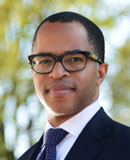September 22, 2015 — Jonathan Capehart, a member of The Washington Post editorial board, writer for the PostPartisan blog, and MSNBC contributor, discussed the parallels between the Black Lives Matter and marriage equality movements, the role of the media, and the 2016 election.
Both the Black Lives Matter and marriage equality movements are “linked in ways that go beyond a quest for equal justice,” said Capehart. Bringing social problems and individual stories to light was instrumental in furthering both causes.
“Before this year, the nation always found a way to dismiss, discount, or even disbelieve the complaints that African Americans had had,” said Capehart. But with videos of the deaths of Eric Garner, Tamir Rice, and many other instances of police brutality being recorded and released, “we all got to see what Blacks had been complaining about and demanding that the entire nation see, for generations,” which helped give momentum to the Black Lives Matter movement, said Capehart.
Similarly, “knowing someone gay was the equalizer” in the fight for marriage equality. In 2001, 57 percent of Americans were opposed to gay marriage; by 2015, 55 percent were supportive, said Capehart, because of an increase in the number of gay people coming out. “It’s difficult to support something or someone you can’t see,” he said. Both movements also involved grassroots organizing of people “who simply got tired of systematically being denied access to the American dream, equal treatment under the law as guaranteed by the Constitution.”
Yet, “with every kumbaya moment comes backlash,” said Capehart regarding recent progress. The Black Lives Matter movement has been labeled as violent, while religious freedom laws are springing up around the U.S., demonstrating that the Supreme Court ruling “was not an outright victory” for the LGBT community, but rather a first step toward full equality. As an example, Capehart cited the lack of national protections against workplace discrimination based on sexual orientation.
Regarding the role of media in the two movements, traditional media was the driver in the marriage equality movement, including the portrayal of gay characters in popular culture, while social media has been the primary driver of information for the Black Lives Matter movement, said Capehart.
The democratization of information has allowed everyone access to an array of news and sources, but the downside is that “we now cut ourselves off from opposing points of view,” said Capehart. “We now get our news and information from institutions, news outlets, journalists, thought leaders who reinforce, rather than challenge our world view,” with Facebook and Twitter specifically making the problem worse.
In a question and answer session, Capehart also addressed the outlook for the 2016 presidential election in relation to the nation’s growing diversity. The Republican base is “really, really angry,” said Capehart, in part because they feel that “their vision of the country” is moving away from them, as was evidenced by the election and reelection of President Obama. “The country that the Republican base thought is ‘their country’ is just not there.”
Although candidates like Trump and Carson play to the Republican electorate’s desire for outsider candidates, Capehart predicted that ultimately, Trump and Carson’s rhetoric “is going to do long-term damage to the Republican Party.” Capehart referenced a 2013 GOP report that advised the party to back comprehensive immigration reform in order to become “a national party again.” Until Republican candidates adopt a tone that is more welcoming to Latinos, Capehart expressed doubt that the party could move beyond “a white, southern, regional, reactionary party.”
Capehart also addressed, among other topics, critiques of the Black Lives Matter movement, the role of the courts in the legislative process, the role of activists and mass movements in effecting change, voter suppression laws, and the Kim Davis controversy. Listen to the full audio recording above.
Article and photo by Nilagia McCoy of the Shorenstein Center.


